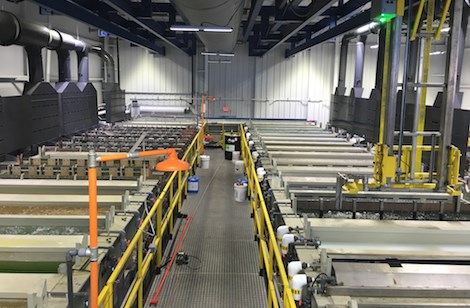C&R Plating Completes $2.5 Million Expansion
Project includes a 6,600 square foot addition and a new 8-station rack zinc and zinc nickel plating line.

C&R Plating in Columbia City, Indiana has completed a $2.5 million renovation and expansion project that included a 6,600 square foot addition and a new 8-station rack zinc and zinc nickel plating line.
C&R Plating, a wholly-owned subsidiary of Michigan-based KC Jones Plating Company, now has a total 37,000 square feet of space, said Mark Burger, KC Jones Plating’s business development and marketing manager.
Burger said C&R Plating added a new highly- automated, computer-controlled plating line that allows it to double its plating capacity and help clients in the agriculture, commercial, automotive, defense and electronics industries.
Palm Technology in Nashville, Tennessee built the line – which includes an off-line hoist racking system – and Aucos Controls from Germany was used for the line operations. KCH Systems in Forest City, North Carolina provided the ventilation system, and the line has two of the first Asterion Carbo-Dry units that reduce carbonates using a simple and relatively maintenance-free skid mounted system.
Chemistry suppliers for the project were Dipsol’s zinc nickel, Pavco’s zinc, and Asterion cleaners.
Burger said plans are to create up to 29 new jobs in general plating, shift supervision and quality control by 2017. The shop has about 70 employees.
KC Jones Plating Company purchased C&R Plating in 2002. It was incorporated in 1968 with production of zinc and yellow chromate, and expanded to include electroless nickel in 1974.
Related Content
-
How to Maximize Nickel Plating Performance
The advantages of boric acid-free nickel plating include allowing manufacturers who utilize nickel plating to keep up the ever-changing regulatory policies and support sustainability efforts.
-
Liquid Chrome Vs. Chromic Acid Flake
Contemplating how to continue offering chromic acid services in an increasingly stringent regulatory world? Liquid chrome products may be the solution you’re looking for.
-
Advantages to Pumped Eductor Agitation
Not all agitation methods are created equally. Pumped agitation with eductor nozzles can improve process tanks and quickly show a reduction in operating costs while keeping staff safe, following environmental legislation and preventing pollution.















